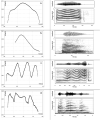Melody complexity of infants' cry and non-cry vocalisations increases across the first six months
- PMID: 33602997
- PMCID: PMC7893022
- DOI: 10.1038/s41598-021-83564-8
Melody complexity of infants' cry and non-cry vocalisations increases across the first six months
Abstract
In early infancy, melody provides the most salient prosodic element for language acquisition and there is huge evidence for infants' precocious aptitudes for musical and speech melody perception. Yet, a lack of knowledge remains with respect to melody patterns of infants' vocalisations. In a search for developmental regularities of cry and non-cry vocalisations and for building blocks of prosody (intonation) over the first 6 months of life, more than 67,500 melodies (fundamental frequency contours) of 277 healthy infants from monolingual German families were quantitatively analysed. Based on objective criteria, vocalisations with well-identifiable melodies were grouped into those exhibiting a simple (single-arc) or complex (multiple-arc) melody pattern. Longitudinal analysis using fractional polynomial multi-level mixed effects logistic regression models were applied to these patterns. A significant age (but not sex) dependent developmental pattern towards more complexity was demonstrated in both vocalisation types over the observation period. The theoretical concept of melody development (MD-Model) contends that melody complexification is an important building block on the path towards language. Recognition of this developmental process will considerably improve not only our understanding of early preparatory processes for language acquisition, but most importantly also allow for the creation of clinically robust risk markers for developmental language disorders.
Conflict of interest statement
The authors declare no competing interests.
Figures



References
-
- Hirst D, Di Cristo A. Intonation Systems. A Survey of Twenty Languages. Cambridge: Cambridge University Press; 1998.
-
- Vicenik C, Sundara M. The role of intonation in language and dialect discrimination by adults. J. Phon. 2013;41:297–306. doi: 10.1016/j.wocn.2013.03.003. - DOI
-
- Nazzi T, Floccia C, Bertoncini J. Discrimination of pitch contours by neonates. Infant Behav. Dev. 1998;21:779–784. doi: 10.1016/S0163-6383(98)90044-3. - DOI
Publication types
MeSH terms
LinkOut - more resources
Full Text Sources
Other Literature Sources

